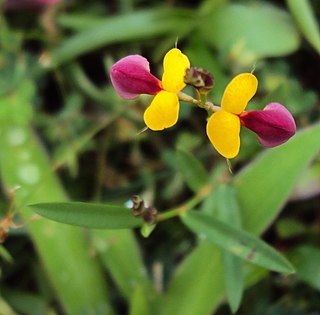
The Cyperaceae are a family of graminoid (grass-like), monocotyledonous flowering plants known as sedges. The family is large, with some 5,500 known species described in about 90 genera, the largest being the "true sedges" genus Carex with over 2,000 species.

Calamus is a genus of flowering plants in the palm family Arecaceae that are among several genera known as rattan palms. There are an estimated 400 species in this genus, all native to tropical and subtropical Asia, Africa, and Australia. They are mostly leaf-climbing lianas with slender, reedy stems. To aid scrambling some species have evolved hooks on the underside of the midrib, or more commonly by modified "pinnae" or tendrils in the form of stout, backward-pointing spines. These stems may grow to lengths of 200 metres.

Tribulus is a genus of plants in the family Zygophyllaceae and found in diverse climates and soils worldwide from latitudes 35°S to 47°N. The best-known member is T. terrestris, a widespread invasive species and weed.

Virola is a genus of medium-sized trees native to the South American rainforest and closely related to other Myristicaceae, such as nutmeg. Species are known commonly as epená, patricá, or cumala. They have glossy, dark green leaves and clusters of tiny yellow flowers, and may emit a pungent odor.

The Myristicaceae are a family of flowering plants native to Africa, Asia, Pacific islands, and the Americas and has been recognized by most taxonomists. It is sometimes called the "nutmeg family", after its most famous member, Myristica fragrans, the source of the spices nutmeg and mace. The best known genera are Myristica in Asia and Virola in the Neotropics.

Parkia is a genus of flowering plants in the legume family, Fabaceae. It belongs to the subfamily Mimosoideae. Several species are known as African locust bean.

Alysicarpus is a genus of flowering plants in the legume family, Fabaceae. It is distributed in tropical and subtropical regions of Africa, Asia and Australia. Species are known generally as moneyworts.

Actinotus is a genus of flowering plants in the family Apiaceae, subfamily Mackinlayoideae, with about 18 species. It is native to Australasia. Its best known member is the flannel flower, a common sight in Sydney bushland in the spring. The generic name, meaning "furnished with rays" is derived from the Greek stem aktin-/ακτιν- "ray" or "sunbeam".

Gymnacranthera is a genus of flowering plants in the family Myristicaceae found from Peninsular Malaysia and Sumatra to New Guinea and the Philippines.
Iryanthera is a flowering plant genus in the family Myristicaceae.

Knema is a genus of plant in family Myristicaceae, mostly consisting of small-medium trees found in lowland tropical forests from Asia to New Guinea. The highest diversity of species is in Borneo.

Monodora is a genus of plant in family Annonaceae. It contains approximately 15 species, distributed throughout tropical Africa.

Myristica globosa is a species of plant in the family Myristicaceae. It is found in Papua New Guinea the Solomon Islands and Australia.

Oxylobium, also known as shaggy pea, is a genus of flowering plants in the family Fabaceae. The genus is native to Australia.

Virola carinata is a New World, tropical evergreen tree in the family Myristicaceae that is indigenous to Colombia, Venezuela and Brazil. It grows to a height of about 30m and its fruit is subglobular, 16–20 mm long and 17–19 mm in diameter, found in groups of 4 to 12.

Pycnanthus angolensis is a species of tree in the nutmeg family, Myristicaceae. It is native to Tropical Africa. Its English language common names include African nutmeg, false nutmeg, boxboard, and cardboard. In Africa it is widely known as ilomba.
Scyphocephalium is a genus of plants in family Myristicaceae native to west Africa, containing two species. One species contains chemicals with significant in vitro antibacterial activity.
Coelocaryon is a genus of flowering plants in the family Myristicaceae. It is native to tropical Africa.
Endocomia is a genus of flowering trees in the family Myristicaceae with a distribution ranging from Indochina to New Guinea. It is distinguished from the other Asian genera by its monoecious inflorescences which are unique in the mostly dioecious Myristicaceae. The only other place where monoecy is reported in the family is in a few Iryanthera species in South America.
Stillingia acutifolia is a species of flowering plant in the family Euphorbiaceae. It was originally described by George Bentham as Sapium acutifolium in 1842. Its native range includes Mexico, Guatemala, and Honduras.














